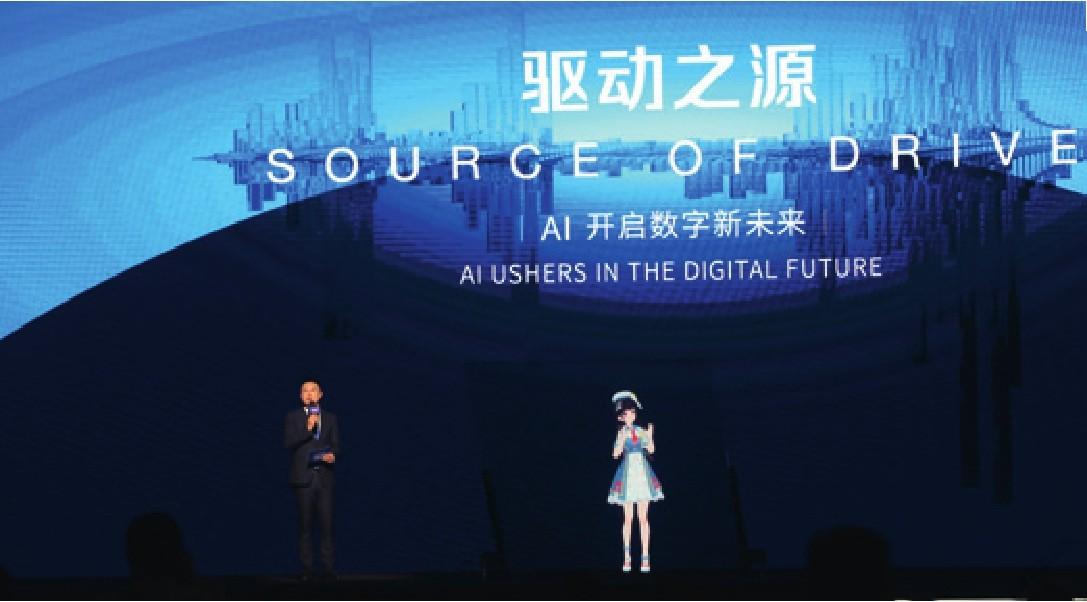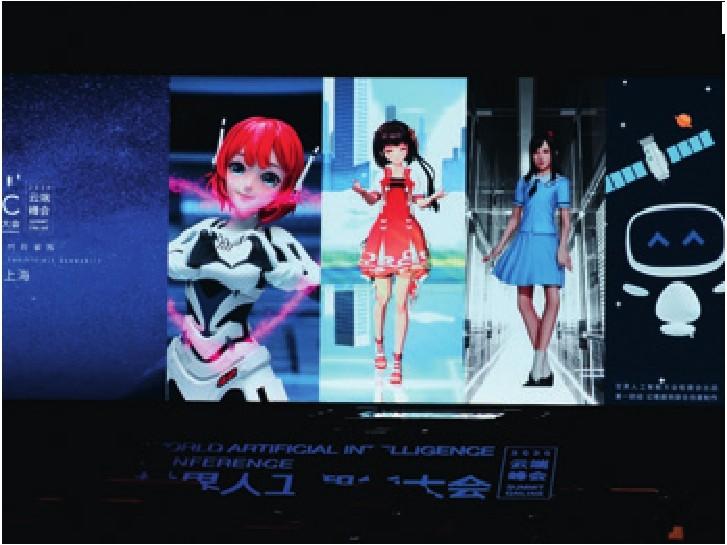The Future of Virtual Metahumans
2022-07-05ByZhangLijuan
By Zhang Lijuan
The day before winning gold in the women’s freeski big air competition at the Olympic Winter Games Beijing 2022, 18-year-old athlete Gu Ailing (Eileen Gu) was still at a studio recording a Winter Olympic television program. At first, the audience may have been wondering: Shouldn’t Gu be focusing on preparing for her final? But after a closer look, they would have noticed that it wasn’t actually Gu herself in the studio, but her digital avatar, known as MeetGu.
Digital avatars, also known as virtual digital humans (VDHs), are created by integrating people’s personal appearances, voices, facial expressions and body language into a digital display.
This was not the first time that artificial intelligence technology like MeetGu has caused a sensation. Before that, the Vanke virtual employee Cui Xiaopan, Tsinghua’s virtual outstanding female student Hua Zhibing, and TikTok virtual beauty expert Liu Yexi, among others, have brought this technology to the public’s attention. During the coverage of the 2022 Beijing Winter Olympics, the weather anchor Feng Xiaoshu, and the AI sign language anchor Lingyu lifted the popularity of VDH technology to new heights.
The soaring capital investment which this sector has attracted also shows the deep interest the public has in this technology. Relevant statistics show that the first month or so in 2022 saw nearly 100 financing deals in the field of VDH, involving 411 million yuan ($61.3 million).
The concept of VDH was first proposed in the 1980s, but only become popular in 2022. Many people believe that its recent popularity can be attributed to the prevalence of the metaverse concept.
“Behind the rising popularity of VDH are the rapid developments that are occurring within the industry,” said Li Shiyan, director of Baidu’s intelligent cloud AI human-computer interaction laboratory, adding that user demand and tech advancements have become the driving forces behind the boom of the digital human sector. At present, China’s intelligent market size is estimated at more than 1 trillion yuan ($149 billion). With the support of artificial intelligence, virtual humans can meet the varied needs of customers. In addition, from 2017 to 2021, the government introduced a slew of policies to support the development of digital-related industries, and the influx of capital has further fueled the boom.
Zuo Pengfei, an associate researcher at the Institute of Quantitative and Technological Economics of the Chinese Academy of Social Sciences, believes that the rapid development of VDH is riding the wave of the metaverse concept, which has led to the introduction of various VDHs by many enterprises and institutions. However, fundamentally speaking, the development of VDH is inseparable from the rapid development of virtual reality technology, users’ needs for highly anthropomorphic virtual images, and enterprises’ needs to convey corporate values and ideas through VDH.
“We cannot deny the role the metaverse has played as a catalyst for the development of the VDH industry. With the growing popularity of the metaverse concept, the number of companies investing in VDH is soaring and the market is booming,” said Yan Mei, an engineer at the Cloud Computing and Big Data Research Institute under the China Academy of Information and Communications Technology. According to Yan, there are three reasons why VDH can take advantage of the metaverse. First, with the rapid advancement of digital human technology, its usability has greatly improved. Second, the application of digital humans has very broad prospects, being able to meet the needs of consumers for intelligent production of digital content and visual interaction. Third, its application environment is favorable. As video becomes a major content carrier, it is a trend to create visual products through digital human technology.
The idea of a VDH is not entirely new. Over the past few years, driven by technology and demand, various kinds of hyperrealistic VDHs have emerged one after another. On the one hand, emerging media forms represented by short videos and live-streaming provides more application scenarios and commercialization paths for the technology; while on the other hand, virtual digital humans are being utilized in fields such as finance, operation and digital exhibition halls, leading to the emergence of many service-oriented roles such as bank digital employees, virtual idols and anchors, all exhibiting the commercial value of this technology.

Yan indicated that VDH technology is still in its infancy and far from the comprehensive application expected by the public. Even though VDH products have begun entering the market, market demands are showing a trend of rapid growth, and the number of companies entering this industry has also begun to increase, the industry has not yet yielded profits for them on the whole. As a new type of computer application, VDHs can meet the needs of multiple scenarios, but there are still problems such as insufficient accumulation of data and basic technologies, varied product quality, and underdeveloped artificial intelligence(AI) technology.
Li Shiyan said the VDH has now evolved to the 3.0 stage. The first half of this stage is the application of VDH technology on the planar computing platform, mainly mobile phones, computers, and smart devices. The second half of the stage is its application on the space computing platform, mainly virtual reality (VR) and augmented reality devices.
During the past five years, benefiting from the breakthrough of deep learning algorithms, the production process of VDHs has been effectively simplified. Nevertheless, Li Xuechao, Tencent Bot Platform Vice Chairman, still believes that VDH is now moving toward a growth stage of intelligence, convenience, refinement, and diversification. Zuo endorsed this idea by saying, “Currently, VDHs are mostly used for display and are unable to achieve real interaction with people…we are still a certain distance from the extensive application of VDHs in a real sense.”
The VDH technology is still in an early stage of development, but it has a promising future, with great potential for commercialization and large-scale application.
According to Yan, intelligence, convenience, refinement, diversification and civilianization are the future goals of VDH development. With the continuous progress of relevant technologies such as modeling, motion capture, computing capacity and network communication, the sophistication of VDHs will continue to improve. “VDH technology will gradually be applied in multiple scenarios and fields. With the lowering of the application threshold and costs, this technology will eventually become accessible and available to everyone,” Yan said.
Zuo believes that VDHs will become an important application portal of metaverse, working as round-the-clock assistants for users.
“With the development of the metaverse, VDHs will replace the apps we now rely on and become new tools in the metaverse. Therefore, the prospects for the VDH industry are bright as large-scale application will be very likely to become a reality in the future,” Zuo said.
By 2030, the overall market size of VDHs will reach 270 billion yuan($41.5 billion) in China. Benefiting from the huge potential of virtual products,identity-based VDHs will take the lion’s share, creating a market value of around 175 billion yuan ($27 billion). The servicebased VDHs are developing more steadily, with the total scale estimated at more than 95 billion yuan ($14.6 billion).
The rise of VDHs reflects the trend of integrating VR with the real world. Many industry insiders have pointed out there are still many challenges facing the industrialization of this technology, including the AI technology used to create virtual humans still being underdeveloped.
“The lack of platforms in upstream and downstream industries greatly restricts its industrialization, and also establishes an invisible threshold for investment in this industry. Moreover, the development of this technology is also limited by low automation in production, high production thresholds, the immaturity of key technologies, as well as the lack of qualified personnel,” said Li.
According to Li, the difficulties hindering the development of VDH technology in the industry are mainly on the technical side. Speech recognition belongs to perceptual intelligence, while the advancement for machines from simply recognizing speech to understanding speech requires cognitive intelligence. Whether a machine possesses a natural language understanding ability is also a sign of whether it is intelligent enough. How to represent, acquire, learn knowledge and then combine this with data is another a big challenge. The key to the future development of VDHs is to increase their ability to deeply understand scenarios and effectively realize technical upgrades.
So far, the production of digital humans often involves the concerted efforts of several companies. If service-oriented digital humans have a strong intellectual property attribute, together with a certain popularity, the service quality and customer satisfaction will be greatly promoted. As for the performance-oriented digital human, if it can have its own suitable service attributes, its commercial value will be improved remarkably. Presently, none of the attributes have been effectively materialized. Additionally, the cost of meeting high-mobility and highfrequency requirements remains high.
Beyond the technical difficulties, Yan pointed out four more problems restricting the development of VDHs. First, the industry is still in its incubation period, lacking policy and capital support. Second, the supply of qualified personnel is unstable. Third, good and bad product quality are intermingled due to the lack of unified technical standards and systems in the industry. Fourth, relevant laws, regulations and ethical norms have yet to be improved, with potential risks in safety ethics.
According to Li the industry urgently needs a complete talent supply system, especially a cross-field talent system, in a bid to ensure the healthy operation of the industry. Furthermore, relevant laws and regulations and ethical norms need to be improved to avoid future legal issues and ethical risks.
Zuo put forth the following suggestions for avoiding future problems: Efforts should be made to guide related enterprises to focus on technological innovation while respecting the law of development for this emerging industry, and VDH technological innovation should be focused on meeting consumers cultural needs. Besides taking measures to promote its growth, the country should also improve supervision and administration to increase the industry’s capacity to self-regulate. Additionally, enterprises and research institutes should be encouraged to quicken the formulation of related industrial standards as to advance the development of the VDH industry. The legislative branch of the government should carry out forward-looking legislation, taking ethics and safety into consideration while ensuring the innovative vitality of the industry. BR

